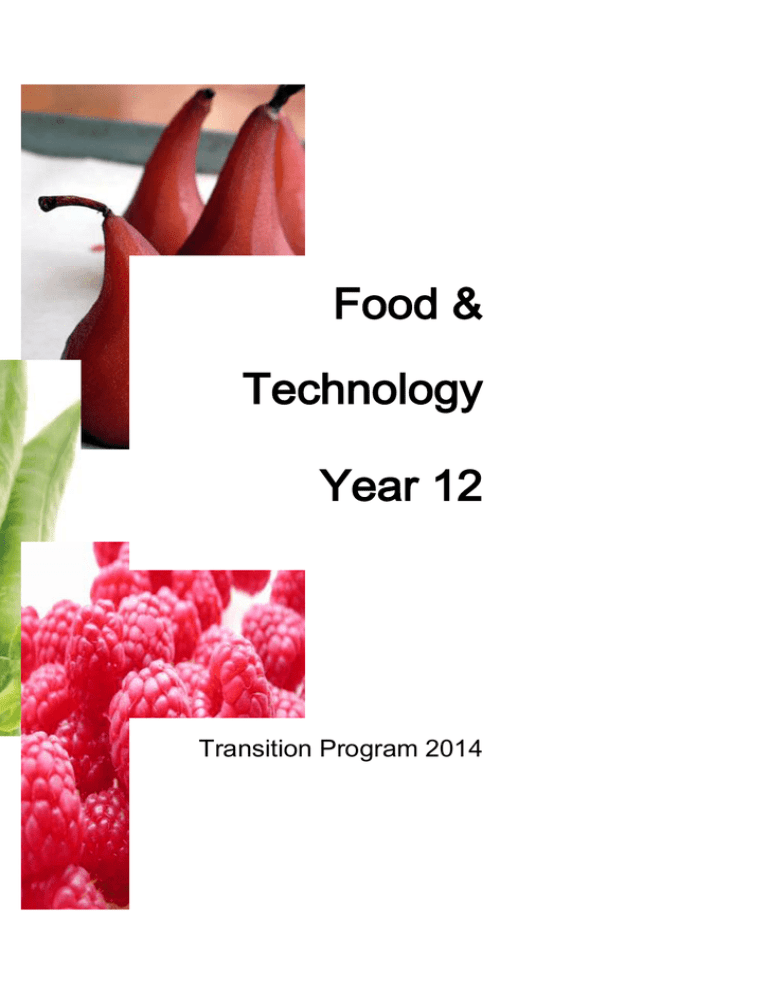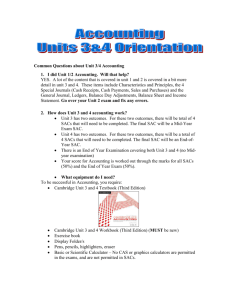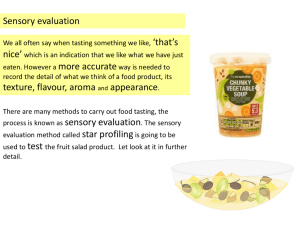Food and Technology Transition Booklet (1)
advertisement

Food & Technology Year 12 Transition Program 2014 Name ___________________________ FOOD & TECHNOLOGY 2015 Course Outline Unit 3 Area of study 1 Maintaining food safety in Australia In this area of study students develop an understanding of the roles and responsibilities of and the relationship between the national, state and local authorities that govern food laws and standards to maintain food safety in Australia, including the production of safe food and the labelling of manufactured products. Students examine the causes of food spoilage and food poisoning and the practices followed to prevent them occurring. They investigate how the HACCP system is used in the food industry to ensure that safe and hygienic food is produced. AREA OF STUDY 2 Food preparation and processing In this area of study students demonstrate understanding of key foods and the primary and secondary processes that are applied to them. They examine the natural food components of key foods and analyse how their functional properties may have an impact on food preparation and processing techniques. Students explore and apply a range of cooking, food preparation, processing and preservation techniques of key foods, while following food safety and hygiene requirements. AREA OF STUDY 3 Developing a design plan In this area of study students develop a design plan to meet the requirements of a specific design brief. They initially develop a design brief and evaluation criteria drawn from the design brief. They then investigate its specifications, consider and justify food item choices and develop a design plan to be implemented in Outcome 1, Unit 4. Students research aspects related to their design brief that may include the functional properties of ingredients, relevant processing techniques, tools and equipment, safety and hygiene practices, and specific needs of the consumer/s. They incorporate the findings of their research and exploration in the design plan. After making and recording decisions about the proposed four to six food items that will comprise the product, students develop an overall production timeline. Unit 4 Area of study 1 Implementing a design plan In this area of study students apply design and product development processes. They develop individual production plans for the four to six food items proposed in Unit 3, Outcome 3. Using the design plan, students use appropriate tools and equipment to safely and hygienically implement a range of preparation, processing, preservation and presentation techniques. This range should include complex processes, which are hands-on processes resulting from a series of decisions about critical variables that directly affect the outcome of combining ingredients, equipment and techniques that result in a food item. As a result of ongoing evaluation, students make and record modifications as required. Students conduct and record results of sensory analysis for each food item including appearance, aroma, flavour and texture. They present and evaluate the product using the sensory analysis and the evaluation criteria devised in Unit 3, Outcome 3. They evaluate the effectiveness and efficiency of production activities in relation to their individual food item production plans. AREA OF STUDY 2 Food product development In this area of study students investigate the impact of primary food production on the environment and changes being made to achieve more sustainable farming practices. They also investigate environmental issues in food manufacturing and packaging. Students consider the types of food product development and the driving forces related to these developments. They examine the process of commercial food product development from the design brief and planning stage to the prototype, production, packaging, labelling, marketing and evaluation of the final product. Students explore new and emerging foods and innovations in food product development as a result of social pressures, consumer demands and expectations. They explore the impact of technology on food production and packaging, and the development of new food products. Text Lasslett & Collins, (2010) Food for VCE Units 3 & 4, Cambridge University Press Assessment A variety of different methods will be used to assess your knowledge, including: Tests (short and/or extended answer) Structured questions Short written reports Case studies School Assessed Task (SAT) Exam SACs Unit 3 SACs: Unit 4 SACs: School Assessed Task End-of-year examination: Most of the SACs will be closed book and require responses to detailed short answer questions Sometimes stimulus material or a case study is provided prior to the SAC. SACs may be prepared for by following the ‘SAC preparation sheet’, which will provide brief outlines of the content that is assessable. 18% 12% 40% 30% Examination The exam in November is 90 minutes long (100 marks) and consists of MCQ’s, short answer questions and one extended response testing Units 3 & 4. VCAA detailed information The study design can be found on this page: http://www.vcaa.vic.edu.au/vce/studies/foodtech/foodtechindex.html Tips for success in Food & Technology 1. Attendance- minimum of 80% attendance: if you miss class, it is your responsibility to catch up on work 2. Be organised- have a folder organised into Areas of Study (two for Unit 3 and one for Unit 4), have an A4 lined exercise book which you will be referred to as your ‘Journal’. Your netbook should be operational and charged. You should always have your Diary if there is a necessity to leave the room. Make sure you have all the necessary stationary and finally be prompt to class. 3. Complete all work requirements- come into class prepared to work 4. Seek feedback- particularly on folio work, complete all practice SAC questions 5. Your teacher is your best resource- meet regularly with teacher during own time or organise to come as a small group 6. Detail- the students who do well go beyond the basic detail and use terminology with confidence 7. Start planning now for SAT- begin thinking of themes, collecting recipes and pictures 8. Practice- when it comes to folio products, practice your food items at home- remember you will be assessed on your skills demonstrated in class 9. Revise from the beginning- make your life easy when it comes to exam time. Maintain a working glossary in your ‘Journal’, do AOS (SAC) summaries, use revision tools such as summary tables, flow charts and concept maps Consistency throughout the year is the key to success in any subject! Work to complete… HOLIDAY HOMEWORK Instructions This work is to be submitted the first day in term 1 that you have F&T. Late submission of work is not a good start to the year Several of these exercises require research and overall this task is quite time consuming, so allow plenty of time to get it done to the very best of your ability. Try to complete it within the last 2 weeks of the holidays before returning to school as it will then be still fresh in your mind - easier to remember. Topic Work to complete Text pages 2 1. Complete Activity 1.1 – Questions 1-4 Read all of Chapter 1 ‘Food spoilage and poisoning’ before you start the following: 2. Complete Test Your Knowledge- Questions 1-5 3. Complete Activity 1.5 – Make a list 5. Complete Test Your Knowledge – Questions 1-5 6. Complete Activity 1.10 – Practice Exam Question 11 12 19 20 EXTRA 1. Complete the quiz at http://www.betterhealth.vic.gov.au/bhcv2/bhcarticles.nsf/pag es/Quiz_food_safety?open 2. Complete Design Brief 15 Done If possible aim to cook at least 4 items over the holiday break – something a bit more challenging than 2-minute noodles! Practical work Photograph these food items and evaluate the success of each product according to their sensory properties i.e. flavour, appearance, viscosity, texture/mouthfeel. I suggest one of each of the following Entrée Main course – using meat or seafood Dessert something challenging Cake/Biscuits – using creaming method However, 4 different items of any kind is better than none. ACTIVITY 1.1 – QUESTIONS 1-4 – P. 2 1. ______________________________________________________________________________________ ______________________________________________________________________________________ ______________________________________________________________________________________ ______________________ 2. ______________________________________________________________________________________ ______________________________________________________________________________________ ______________________________________________________________________________________ ______________________ 3. ______________________________________________________________________________________ ______________________________________________________________________________________ ______________________________________________________________________________________ ______________________ 4. ______________________________________________________________________________________ ______________________________________________________________________________________ ______________________________________________________________________________________ ______________________________________________________________________________________ ___ TEST YOUR KNOWLEDGE – QUESTIONS 1-5 – P. 11 1. 2. 3. 4. ACTIVITY 1.5 – TABLE – P.12 EXAMPLE A knife that has been used for cutting raw meat is not washed thoroughly before it is used for slicing cooked meat. TEST YOUR KNOWLEDGE – QUESTIONS 1-5 – P.19 1. 2. INFECTIVE FOOD POISONING 3. TOXIC FOOD POISONING 4. 5. ACTIVITY 1.10 – PRACTICE EXAM QUESTION – P.20 Practical Work Aim to cook at least 4 challenging food items over the holiday break. 1. Photograph these food items. 2. Evaluate the success of each product according to their sensory properties (descriptive words). Food item Aroma Appearance Flavour Mouthfeel/ texture Design Brief Constraint Considerations Evaluation Criteria 1. ___________________________________________________________________ ___________________________________________________________________ 2. ___________________________________________________________________ ___________________________________________________________________ 3. ___________________________________________________________________ ___________________________________________________________________ 4. ___________________________________________________________________ ___________________________________________________________________ Health and Safety Practices Health Safety Evaluation 1. __________________________________________________________ __________________________________________________________ __________________________________________________________ __________________________________________________________ __________________________________________________________ __________________________________________________________ __________________________________________________________ __________________________________________________________ __________________________________________________________ __________________________________________________________ __________________________________________________________ __________________________________________________________ __________________________________________________________ __________________________________________________________ __________________________________________________________ __________________________________________________________ 2. __________________________________________________________ __________________________________________________________ __________________________________________________________ __________________________________________________________ __________________________________________________________ __________________________________________________________ ______________________________________________________ 3. Peer Evaluation Rate my summer salad and egg mayonnaise 1= needs work 2=OK 3=good 4=delicious Appearance Aroma Taste Texture





